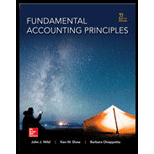
Concept explainers
Concept Introduction:
A liability can be defined as an obligation which a person or a company needs to pay which arises during the course of the business.
A liability can be short term or long term depending upon the time period in which it is required to be paid. If a liability is required to be paid with in a period of 12 months i.e. one year it will be treated as current liability and if a liability is required to be paid beyond a period of 12 months or one operating cycle, it will be treated as long term liability.
To determine:
Difference between a current and long-term liability
Explanation of Solution
A liability can be defined as an obligation which a person or a company needs to pay which arises during the course of the business.
A current liability can be defined as the liability that is required to be paid within a period of 12 months or one operating cycle. Example accounts payable, short term notes payable.
While a long term liability can be defined as the liability that is required to be paid in a period of more than 12 months or one year or one operating cycle. Example – Bonds issued for 5 years, loan taken from bank to be paid in 3 years etc.
The difference between a current and long-term liability can be elaborated as under –
| Basis | Current Liability | Long-term Liability |
| Time period | It is required to be paid with a period of 12 months or one operating cycle of the |
It is required to be paid beyond a period of 12 months or one operating cycle of the balance sheet. |
| Examples | Example are accounts payable, notes payable, wages and salaries, interest, dividends, short term loans etc. | Examples are leases, bonds issued for more than one year, pension obligations, |
| Recording in the balance sheet | Recorded in the balance according to the occurrence of their due dates in the current liability section. | They are recorded in a separate section under the head long-term liabilities in the balance sheet. |
Thus, it can be concluded that, the main difference between current and long term liability is that a current liability is required to be paid within a period of 12 months while, a long term liability is required to be paid beyond a period of 12 months.
Want to see more full solutions like this?
Chapter 11 Solutions
Fundamental Accounting Principles -Hardcover
- Bruno Manufacturing uses direct labor-hours in its predetermined overhead rate. At the beginning of the year, the total estimated manufacturing overhead was $680,000. At the end of the year, actual direct labor-hours for the year were 42,500 hours, manufacturing overhead for the year was underapplied by $25,500, and the actual manufacturing overhead was $695,000. The predetermined overhead rate for the year must have been closest to: A) $16.00 B) $15.75 C) $16.35 D) $16.94arrow_forwardWhat was manufactured overhead?arrow_forwardWhich of the following choices is the correct status of manufacturing overhead at year-end?arrow_forward
- Morris Corporation applies manufacturing overhead at the rate of $40 per machine hour. Budgeted machine hours for the current period were anticipated to be 200,000; however, higher than expected production resulted in actual machine hours worked of 225,000. Budgeted and actual manufacturing overhead figures for the year were $8,000,000 and $8,750,000, respectively. On the basis of this information, the company's year-end overhead was: A. overapplied by $250,000 B. underapplied by $250,000 C. overapplied by $750,000 D. underapplied by $750,000arrow_forwardAt the beginning of the year, manufacturing overhead for the year was estimated to be $560,000. At the end of the year, actual labor hours for the year were 35,000 hours, the actual manufacturing overhead for the year was $590,000, and the manufacturing overhead for the year was underapplied by $30,000. If the predetermined overhead rate is based on direct labor hours, then the estimated labor hours at the beginning of the year used in the predetermined overhead rate must have been ___ hours.arrow_forwardGive me Answerarrow_forward

 AccountingAccountingISBN:9781337272094Author:WARREN, Carl S., Reeve, James M., Duchac, Jonathan E.Publisher:Cengage Learning,
AccountingAccountingISBN:9781337272094Author:WARREN, Carl S., Reeve, James M., Duchac, Jonathan E.Publisher:Cengage Learning, Accounting Information SystemsAccountingISBN:9781337619202Author:Hall, James A.Publisher:Cengage Learning,
Accounting Information SystemsAccountingISBN:9781337619202Author:Hall, James A.Publisher:Cengage Learning, Horngren's Cost Accounting: A Managerial Emphasis...AccountingISBN:9780134475585Author:Srikant M. Datar, Madhav V. RajanPublisher:PEARSON
Horngren's Cost Accounting: A Managerial Emphasis...AccountingISBN:9780134475585Author:Srikant M. Datar, Madhav V. RajanPublisher:PEARSON Intermediate AccountingAccountingISBN:9781259722660Author:J. David Spiceland, Mark W. Nelson, Wayne M ThomasPublisher:McGraw-Hill Education
Intermediate AccountingAccountingISBN:9781259722660Author:J. David Spiceland, Mark W. Nelson, Wayne M ThomasPublisher:McGraw-Hill Education Financial and Managerial AccountingAccountingISBN:9781259726705Author:John J Wild, Ken W. Shaw, Barbara Chiappetta Fundamental Accounting PrinciplesPublisher:McGraw-Hill Education
Financial and Managerial AccountingAccountingISBN:9781259726705Author:John J Wild, Ken W. Shaw, Barbara Chiappetta Fundamental Accounting PrinciplesPublisher:McGraw-Hill Education





